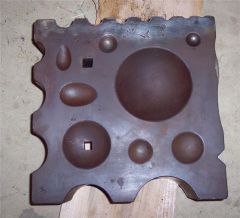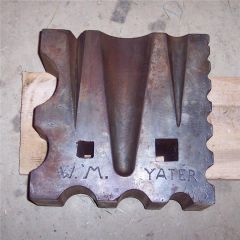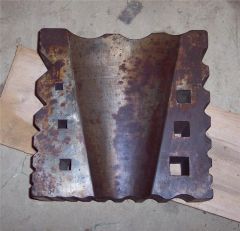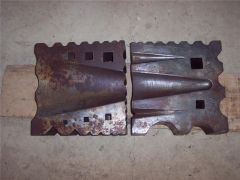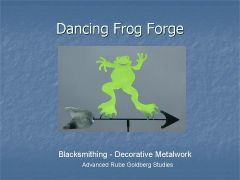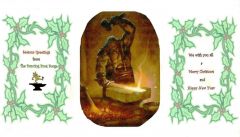-
Posts
2,237 -
Joined
-
Last visited
Content Type
Profiles
Forums
Articles
Gallery
Downloads
Events
Everything posted by rthibeau
-
Contest - Design an anvil stand
rthibeau replied to Glenn's topic in Anvils, Swage Blocks, and Mandrels
Okay, it's January 2, 2007......how do we submit/publish, etc our entries for comparison or consideration or just general viewing by the collective audience? -
The BPs on Flux Containers, Campfire Tripods, and Glenn's various junkyard visits, seeing things different and storage were all informative and useful. My picks for immediate most useful to me were: BP 0072 - Hammer Making by Jr Strasil; BP 0129 - Ring Roller by Garey Ford; BP 0326 - Courting Candle by Gerald Franklin.
-
I don't want to sound crude...but after all this time.....no damascus..no pattern?...no good beer??... what;'s uip?
-
ooh, I just saw Glenn's " since the beginning of time" thingy....cool beans....
-
Ted. has anyone ventured to say..."give it up?"
-
Good Coal & Blacksmithin Newbe
rthibeau replied to Ron Hicks's topic in Blacksmithing, General Discussion
While googling the contact info for our coal supplier, I came across this page of the Appalachian Blacksmiths Association website Coal & Coal for Sale They have contact info for several suppliers..the Sewell vein is what we get from the Green Valley Coal Company. The trick is to buy a full truckload...up to 30 tons....to get the best price and mitigate the shipping cost. -
I would agree with everyone who said only a few hammers are really needed to do general blacksmithing; however, the accumulation of hammers and other sorts of tools is a natural habit of the trade. I made this rack hoping it would hold almost everything in one place. It replaced 3 or 4 other racks so I guess I did gain some room....somewhere...:)
-
From the album: rthibeau
another attempt to gain back space and organize -
Probably the most difficult thing for me to understand was the clinker thing ...the coal I use doesn't produce any clinkers unless I use flux in forge welding. After I finish a session of forging in the coal forge, I clean it out to make sure the fire is out, but there is never anything to take out such as clinkers. So, my conclusion is, I must be doing something different or I'm using some really good coal. Does everyone else always get clinkers in coal or what??
-
Clinkers are fused debris and stuff that will "clink" when tapped with a metal fire tool like a rake and is heavier. Unburnt coke is light and will break up.
-
From the album: rthibeau
-
Just a moment to step back and reflect on the year past, and maybe turn a eye towards the next. From all of us to all of you, Best Wishes and prayers for a good New Year. Happy Holidays, everyone.
-
From the album: rthibeau
A blacksmithing themed greeting card from the Dancing Frog Forge. Best wishes to All. -
IForgeIron Blueprints Copyright 2002 - 2011 IFORGEIRON, All rights reserved BP0396 Shop Storage by Richard Thibeau When finally the point is reached that one is allowed to have a separate shop to work in, a building is erected to house all the toys...er, that is, the necessary tools and equipment. This is only the beginning of an ongoing dilemma. The shop building is never large enough to easily house everything that is dragged home, that is to say to adequately store the necessary tools, equipment, and materials needed. It is not long before piles of stuff begin to grow. The shop interior can become cluttered looking to the untrained spousal eye. As a self preservation matter, some means of organizing has to be implemented to move important items out of the way when not being actively utilized. Small tools are commonly left wherever they were set down last which often is not where one looks for them later. Electric tools also have dangling cords that become unruly. A beginning only, but hanging tools in easily accessible locations, such as under the edge of the bench, is a habit to encourage. Other handy locations are right over head in a lot of instances. Up out of the way, but still within easy reach. Empty air is a fine storage location when properly utilized. Make hooks of the size to fit whatever item is being hung up and of the length necessary to be above head level (walls are for banging heads against, not tools) yet still within easy reach. The hooks are placed over the rafters, joists, trusses, whatever is there. A length of pipe can be laid across the rafters to provide a place for hooks if there is need to have a hook in a certain place. Hooks can be used to store hooks as well. Things are starting to look up. View full article
-
IForgeIron Blueprints Copyright 2002 - 2011 IFORGEIRON, All rights reserved BP0394 Side Draft Forge by Richard Thibeau At the Dancing Frog Forge, coal is burned in a side draft forge. The construction is fairly simple as the base of the forge is stacked concrete block with a 4’x 4’ SS diamond plate sheet as the table. The chimney is 10 inch diameter stovepipe sitting in chimney block and resting on the table top. The stovepipe goes up to a commercial metal chimney. No mortar was used on the block, it is stable because of its own weight. The firepot is from Centaur Forge. At the bottom of the stovepipe, a “T” connector was cut out in an arch for the opening facing the firepot. My favorite method of starting the fire is by using a shovel full of coals from the wood stove. It’s simple, quick, and very efficient. During cooler weather (most of the year around here) the wood stove is the first thing to get going, so there is a ready supply of coals. A little air added to the coals from the wood stove gets them ready for the coal. ' The coal is raked onto the wood coals and a little more air is added. The coal has coke mixed in from the last time the forge was used and catches quite readily. Notice how the flame is being drawn into the side draft of the chimney. More fresh coal is added and the amount of smoke increases, but it is being sucked out and up the chimney. To make this happen easier, either start with a small fire and gradually build it up, or preheat the chimney by placing burning paper or coals from the wood stove inside to start the updraft. The fire is now well established and ready for forge work. The more the air is cranked up, the higher the flames go, and the more draft will be produced to suck the flame, smoke, and heat up the chimney. Fresh coal is piled up along the perimeter of the fire and watered to start the coking process. It will be raked into the middle to maintain the fire as work progresses. There will be little, if any, smoke at this stage. At the end of the forging session, the firepot is shoveled out and the coal fire allowed to die out. The coke can be saved separately or left to be used in starting the next fire. In this session, two hammer heads were heated for tempering and no clinkers were formed. The forge is left as is, ready for the next fire to be made. View full article

